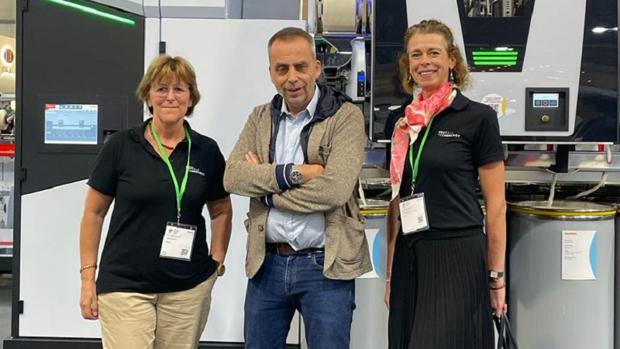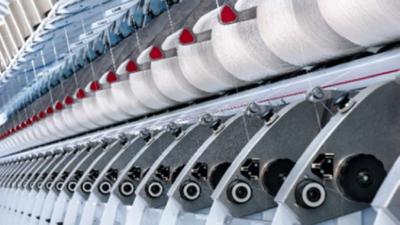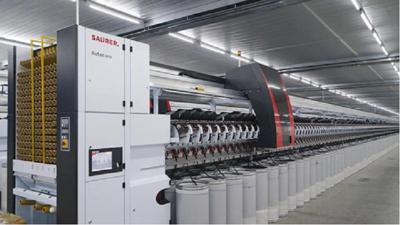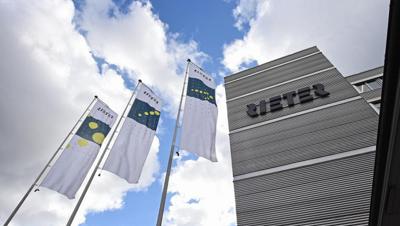
The ITMA is the world’s largest international textile and garment technology exhibition. During the ITMA 2023 in Milan/Italy we talked to Uwe Rondé, CEO of Saurer AG, Arbon/Switzerland, about the dynamic developments in textile industry.
What does automation & digitalization mean for Saurer as a technology company focusing on innovations for the processing of fibers and yarns, including machinery, components and software?
As a technological leader in all spinning processes, Saurer is highly diversified. At the same time, we have been working for a very long time on automation and digitalization as well as sustainability – these topics have been important elements of our development strategy for many years.
In general, it should be noted that digitalization and automation are not ends in themselves. We see our role as that of an enabler and technology partner: We aim to work with our customers to develop new offers that will enhance their value creation. Our business model has changed over the last few years. We have long since ceased to be just a mechanical engineering company and now have a diverse portfolio that includes software services, sensors and automation technology.
We are convinced that digitalization and automation are the key to enabling circular economy approaches. This will further improve the environmental footprint of our industry. As a technology company, we are pioneering all these processes and will support our customers in their use of advanced technologies such as robotics, computer control and sensor networks to automate various stages of the textile production process. Saurer has always been a service company: In the future, consulting services will help our customers integrate automation and digital solutions into existing processes. For us as a technology company, life cycle management, preventive maintenance models with after-sales packages and just-in-time component replacement will play a major role.
What will the spinning mill of the future look like? What will change in yarn spinning in the next 5-10 years? What will remain unchanged?
The textile industry is developing very dynamically. We are currently at a point in a transformation process with many innovations, some of which are only just beginning. This makes it difficult to accurately forecast which developments will shape the construction and operation of a spinning mill in the next 10 years. Nor will it be possible to implement technological innovations everywhere at the same time and with the same intensity. As in all innovation cycles, there will be pioneers and others who follow later.
The spinning mill of the future will use advanced automation technologies and digitalization to improve efficiency and productivity. However, we do not believe that spinning mills will be able to operate fully automatically without any need for personnel any time soon.
Tasks such as material transport will increasingly be taken over by automated machines and robotic systems. Sensors embedded in machinery and equipment collect data to enable real-time monitoring and predictive maintenance. Data analytics and machine learning algorithms can optimize production processes and quality controls, resulting in higher yields and less waste.
The issue of sustainability will influence the construction and operation of spinning mills. The use of renewable energy sources, the introduction of water recycling and water saving systems will all reduce their carbon footprint. The future will belong to environmentally friendly materials and processes, including the use of recycled fibers.
It is also possible that textile processing companies will relocate back to Europe (“reshoring”) in the medium term. A high degree of automation would need to be in place first: Reduced transport distances would lead to an improvement in the environmental balance with no or only minor cost effects.
What are the major challenges in the areas of automation & digitalization?
The textile machinery industry is facing a number of challenges with regard to digitalization and automation. Some of these are similar to those in other sectors. But some are specific to our industry. The textile machinery industry, for example, is made up of a wide range of machines and processes, each with its own technological requirements. Integrating digital technologies into existing machines and ensuring compatibility between different systems can be complex and difficult.
One of the biggest challenges will be cost-effective data collection. Hundreds of thousands of spindles are in use in individual spinning mills; equipping every single one of these spindles with the necessary sensor technology will hardly be feasible due to the associated costs. We will therefore need to use intelligent solutions, possibly including AI, to collect as much process data as possible with as few sensors as possible. Only in this way will it be possible to make the processes transparent enough for digitalization.
Many textile manufacturers still use older machines that may not be designed for digitalization. Retrofitting or upgrading these machines to integrate digital technologies could be costly and technically challenging. Demonstrating a clear return on investment (ROI) and long-term benefits will be critical to driving uptake.
Digitalization generates a large amount of data from various sources such as machines, sensors and production processes. Managing and analyzing this data effectively to derive actionable insights can be challenging. Data integration, standardization and security are important aspects.
The successful implementation of digitalization requires a skilled workforce that is able to operate and maintain digital systems. It will be crucial to recruit and train skilled workers who are familiar with both textiles and digital technologies and to prevent skills gaps from arising in the first place.
Developing industry standards and ensuring compatibility between different digital solutions is therefore of great importance.
Meeting these challenges will require continuous investment in research and development as well as a wide-ranging exchange of knowledge between all partners. Only in this way will we be able to overcome the aforementioned obstacles and drive successful digitalization in the textile industry.
You have now been CEO at Saurer for 1.5 years. Are the turbulent times with the insolvency of the German entities of Saurer and the sales of the embroidery business as well as Schlafhorst automatic winder, Accotex and Temco component businesses over? How is Saurer positioned for the future?
I have only been CEO of the Saurer Group since January 2022 and therefore have a certain distance to the events mentioned. Saurer, like many other companies, has had a difficult time due to the pandemic. But we have left this phase behind us and are very well positioned for the future. Visitors to ITMA will be able to see some very interesting innovations on our stand. Our strength lies in the fact that we turned our attention to megatrends such as sustainability, especially recycling, at an early stage, along with digitalization and automation. For years, Sauer has had design guidelines (E³) that are explicitly oriented towards the criteria of energy saving, economic efficiency, and ergonomics. The latter is a prerequisite for networking the machines and thus the first step towards data-driven decision-making. With “Recycling Xtreme”, we are pursuing an approach that has met with a great deal of interest among our customers. We are no longer “just” a machine manufacturer; instead, we are now positioning ourselves with customers as a technology partner with a broad range of products.
I feel very comfortable at Saurer; I’ve felt very well received by the team and have the impression that I can bring some creative ideas to the company to help its further development.
Transforming the world of textiles – that is this year's ITMA motto. What is your response to this? What is Saurer’s contribution to the transformation of the textile industry?
We look forward to welcoming our customers and partners to ITMA with its theme of “Shaping the future of textiles”. Yarn manufacturers and other customers will have to adapt to new framework conditions (including EU Textile Vision 2030) in the near future and reorganize business models and processes. It is our task as a technology partner to actively help our customers negotiate the upheavals and paradigm shifts that are taking place. Saurer already has suitable solutions and upgrades with which customers can meet the challenges of digitalization, automation and sustainability. At the ITMA 2023, we will be presenting world firsts in both products and solutions for every spinning process.



